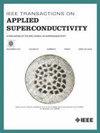双单元1.5 ghz超导射频腔的弹塑性调谐
IF 1.7
3区 物理与天体物理
Q3 ENGINEERING, ELECTRICAL & ELECTRONIC
引用次数: 0
摘要
美国国家同步辐射研究中心(NSRRC)正在开发一种2单元1.5 ghz超导射频(SRF)模块。该SRF腔体的基本π模态频率必须通过对其结构施加纵向位移来调整到特定的公差范围内,将其扩展到弹塑性范围内。建立了考虑结构弹塑性特性的四分之一对称模型来模拟频率调谐过程。采用多物理场计算方法计算了结构变形后SRF空腔的π模频率。除了结构性能和应力分布外,还可以计算出每个调谐步骤的谐振频率以及预调谐后的总体频移。最初,该SRF腔体在构造后具有较小的弹塑性变形。然后经过电抛光和退火后进行完全调谐以达到适当的共振频率。这项工作首次成功地证明了在真空中调谐SRF腔,有效地消除了空气介电常数对频移造成的干扰。本文章由计算机程序翻译,如有差异,请以英文原文为准。
Elastoplastic Tuning on a Two-Cell 1.5-GHz Superconducting Radio-Frequency Cavity
The National Synchrotron Radiation Research Center (NSRRC) is developing a 2-cell 1.5-GHz superconducting radio-frequency (SRF) module. This SRF cavity's fundamental π-mode frequency must be adjusted within a specific tolerance by applying a longitudinal displacement to its structure, extending it into the elastoplastic range. A one-quarter symmetric model is established to simulate the frequency tuning process, taking into account the structural elastoplastic behavior. A multi-physics computing process is also employed to calculate this SRF cavity's π-mode frequency after structure deformation. The resonance frequency at every tuning step, along with the overall frequency shift after pre-tuning, can be computed, in addition to the structural behavior and stress distribution. Initially this SRF cavity is tuned with a small elastoplastic deformation following it's construction. It then undergoes a complete tuning to reach the proper resonance frequency after being electropolished and annealed. This work represents the first successful demonstration of tuning an SRF cavity with its interior in vacuum, effectively eliminating the disturbance caused by air's permittivity on the frequency shift.
求助全文
通过发布文献求助,成功后即可免费获取论文全文。
去求助
来源期刊

IEEE Transactions on Applied Superconductivity
工程技术-工程:电子与电气
CiteScore
3.50
自引率
33.30%
发文量
650
审稿时长
2.3 months
期刊介绍:
IEEE Transactions on Applied Superconductivity (TAS) contains articles on the applications of superconductivity and other relevant technology. Electronic applications include analog and digital circuits employing thin films and active devices such as Josephson junctions. Large scale applications include magnets for power applications such as motors and generators, for magnetic resonance, for accelerators, and cable applications such as power transmission.
 求助内容:
求助内容: 应助结果提醒方式:
应助结果提醒方式:


